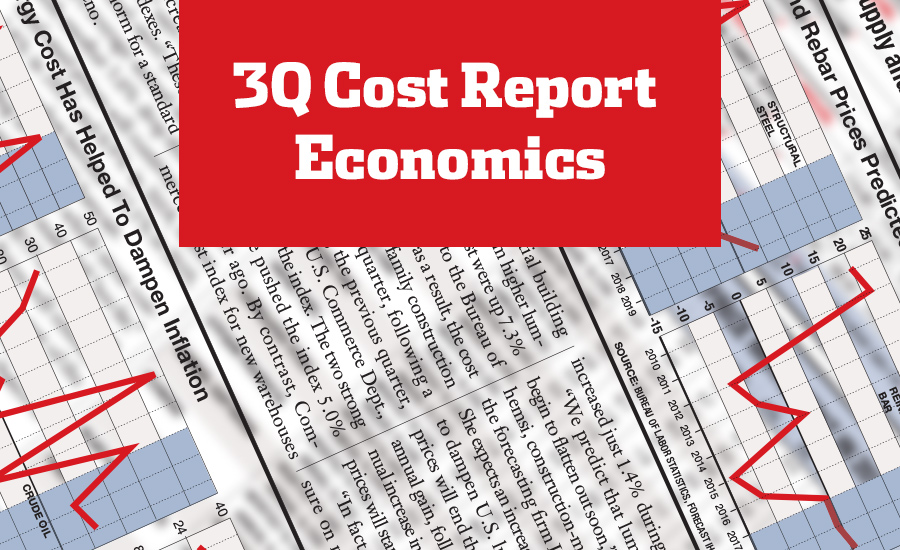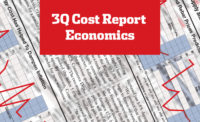While worries regarding the COVID-19 crisis persist, construction is on the road to recovery, according to analysts.
“Construction activity continues to dig itself out of one of the deepest and shortest recessions in U.S. history,” says Richard Branch, chief economist at Dodge Data & Analytics. Still, he warns, “it will be a long road back. Through eight months, the value of total construction starts is 14% below 2019.”
Non-residential starts are down 24% on a year-to-date basis, with declines across the board, according to Dodge data. Branch notes that warehouse construction continues to be the one strong spot, as the popularity of online shopping continues. Non-building construction is down 20% overall, despite growth in the streets and bridges sector. The largest projects that broke ground in recent months include the $1-billion Facebook data center in Gallatin, Tenn.; a $740-million Texas Instruments fabrication facility in Richardson, Texas; and a $1.3-billion wastewater pollution control plant in San Francisco.
Residential construction has remained fairly strong, down less than 1% year-to-date. “Strength in single family starts is offsetting weakness in multifamily construction,” says Branch.
As for the future, Branch points to the end of government programs as a stumbling block for the industry. “The expiration of enhanced unemployment insurance benefits and small business loans that were provided in the CARES Act, the budget crises facing state and local governments and the impending expiration of the FAST Act on Sept. 30 will all have a dampening effect on starts in the months to come,” he says.
David Burstein, senior principal of AEC consulting firm PSMJ Resources, agrees. While PSMJ’s Quarterly Market Forecast (QMF) survey reported that fewer than 15% of respondents had major project delays or cancellations as of August of this year, federal funding will be necessary for this trend to continue.
“The question for 2021 is whether the feds will step up to fund the tax shortfalls experienced by state and local agencies,” says Burstein. “My guess is that they will, but it’s not a certainty. If the feds don’t step up, 2021 will be a rough year for A/E/C firms that serve the state and local markets.”
Fewer than 5% of respondents to the QMF survey reported significant staff reductions, which Burstein credits in part to the Paycheck Protection loan program.
“The AEC Industry has fared much better than most industries during the COVID-19 pandemic,” he adds.
|
Related Link |
Lumber Prices Rising
In the commodities sector, the big story is lumber prices, which have risen 250% since bottoming out in April, according to IHS Markit.
“We have definitely seen some extraordinary increases on lumber prices, specifically softwood lumber prices, here in North America,” says Deni Koenhemsi, senior economist at IHS Markit.
In its third quarter forecast, IHS Markit is predicting a 19.1% increase in softwood lumber prices for 2020, a huge turnaround from the second quarter forecast, which predicted a 0.7% drop in prices for the year. Plywood prices are now expected to be up 4.5% for the year, after a 3.3% decline was predicted in the second-quarter forecast.
Koenhemsi attributes the rising prices to a “classic case of mismatched supply and demand.”
“When the pandemic reached the U.S., producers in the U.S. and Canada both decided to cut production, thinking that housing construction will slow considerably,” she says. But demand quickly rebounded. “We have seen a V-shaped recovery for housing starts and permits.”
Labor Trends
The latest Construction Labor Research Council report on union labor trends shows that the Northwest region received the highest wage increase in 2020, at 3.9%, up from 3.4% in 2019. The Northwest region includes Alaska, Idaho, Oregon and Washington.
The South Central region, which includes Arkansas, Louisiana, New Mexico, Oklahoma and Texas, recorded the lowest wage increase for 2020, at 1.8%.





Post a comment to this article
Report Abusive Comment